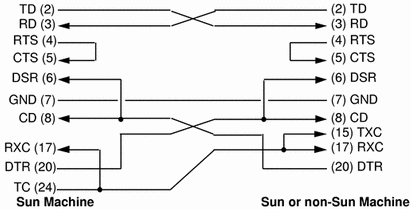

- #PARALLEL TO SERIAL CONVERTER VS NULL MODEM CABLE MAC OS#
- #PARALLEL TO SERIAL CONVERTER VS NULL MODEM CABLE PLUS#
- #PARALLEL TO SERIAL CONVERTER VS NULL MODEM CABLE WINDOWS#
The prefix RS denotes a Recommended Standard, and all of the EIA standards begin with those characters. What does RS232 stand for?ĭata transfer standards are developed by the Electronic Industry Association (EIA). Distances of up to 20 meters are the limit for reliable data transfer using the RS232 interface. It performs asynchronous transmission at a constant rate that is synchronized with the start pulse signal’s level. The RS232 protocol transmits data of wires employing signal levels that differ from the standard 5V in order to minimize signal interference.

We will take a look at the serial port pinouts used to implement RS232 as well as some additional reference information concerning the protocol.
#PARALLEL TO SERIAL CONVERTER VS NULL MODEM CABLE MAC OS#
Multiple operating systems are supported including Windows, Linux, Mac OS etc.Īnother Alternative is to use Bluetooth which is also programmable just like a the older serial port.The RS232 protocol is a popular serial interface that is used to connect computers to peripheral devices such as modems.

NMC cable p/n USB NMC-2.5m comes with an interconnect length of 2.5m (Ĩ.2ft ) - other lengths may be available on request. When used together with FTDI’s supplied Virtual COM Port ( VCP )ĭrivers, the USB NMC cable may be used to establish inter-PC COM Portīased communication at baud rates of up to 3M baud. CTS handshaking signals and interconnects the common GND reference The interconnect cable cross-connects the TXD / RXD data signals, RTS
#PARALLEL TO SERIAL CONVERTER VS NULL MODEM CABLE PLUS#
Together, however each of the USB sockets conceal a small PCB with aįT232RQ based USB-UART converter IC plus support components inside. The outside, this cable appears to be two USB type “A” sockets wired Legacy COM Ports for inter-PC communication.Ī convenient solution to the problem is the FTDI USB NMC cable. This presents a dilemma in application areas that previously relied on USB becomes the multi-function communication port of choice. On modern PCs the legacy COM Port connector is rapidly disappearing as RX and handshaking signals cross-connected so that the PCs couldĬommunicate with each other via legacy COM ports. Such a cable would have DB9 female connectors on each end with the TX PCs using a cable popularly known as a Null-Modem cable. NMC In the era of legacy PCs with onboard RS232 COM Ports, it wasĬommon practice to establish a simple communications network between
#PARALLEL TO SERIAL CONVERTER VS NULL MODEM CABLE WINDOWS#
The FTDI chip cable can be programed in c/c++/c# just like a standard windows serial port by way of a virtual serial port. The only solution that I know of is the "FTDI Chip USB-to-USB Null modem cable" that can transfer between computers two computers using USB ports at a rate of 3 MBaud (384 kbytes/s) That's a lot faster than using older serial ports with null modem cable that maxs out at say 115200 baud (14 kbytes/s). ok for text.ĬOMPUTER AUSBCrossover_AdapterUSBCOMPUTER BĪssuming this beast exists, how do you program it and where do you buy it? I was looking for something with USB speeds to transfer from one computer to another that is not going over a network link such as ethernet or wifi.ĬOMPUTER AUSBUARTNULL_MODEMUARTUSBCOMPUTER B

That's not really what i'm interested in because the baud rate is very slow for uarts. I realize they have USB-to-UART adapters. I was wondering if there was an Adapter of some kind that could emulate this same behavior except for native USB protocol. And then You would read and write them like normal windows files over special system files called "COM1", "COM2", etc. I was curious if anybody knows a way to connect two different computers together over a USB line and what API's exist to program this interface.įor Serial Ports its common to buy a "Null Modem" adapter to cross over the Transmit and Receive lines of the UART so that the computers can talk together.


 0 kommentar(er)
0 kommentar(er)
